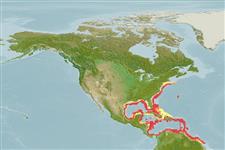>
Polymixiiformes (Beardfishes) >
Polymixiidae (Beardfishes)
Etymology: Polymixia: Greek, poly = a lot of + Greek, myxos = mucus (Ref. 45335).
Eponymy: Rev. Richard Thomas Lowe (1802–1874) was a British botanist, ichthyologist and malacologist as well as being a clergyman. He graduated from Christ’s College, Cambridge (1825) and then took holy orders. He became a pastor in Madeira (1832), [...] (Ref. 128868), visit book page.
More on author: Günther.
Environment: milieu / climate zone / depth range / distribution range
Ecología
marino bentopelágico; rango de profundidad 50 - 600 m (Ref. 5217), usually 150 - 600 m (Ref. 5217). Deep-water; 41°N - 4°N
Western Atlantic: Canada to New York, USA and northern Gulf of Mexico to the Antilles (Ref. 26340) and French Guiana.
Tamaño / Peso / Age
Maturity: Lm ? range ? - ? cm
Max length : 29.4 cm TL macho / no sexado; (Ref. 39376); common length : 15.0 cm TL macho / no sexado; (Ref. 5217)
Espinas dorsales (total) : 5; Radios blandos dorsales (total) : 26 - 32; Espinas anales: 4; Radios blandos anales: 15; Vértebra: 29 - 30. Tip of snout projecting beyond upper jaw (Ref. 13608). Body elongate. Head blunt and rounded. Head and body bluish gray (Ref. 37108). Body with metallic blue shin above, silvery below (Ref. 7251).
Found on soft bottoms (Ref. 5217).
Life cycle and mating behavior
Madurez | Reproducción | Puesta | Huevos | Fecundidad | Larva
Robins, C.R. and G.C. Ray, 1986. A field guide to Atlantic coast fishes of North America. Houghton Mifflin Company, Boston, U.S.A. 354 p. (Ref. 7251)
IUCN Red List Status (Ref. 130435: Version 2024-1)
Threat to humans
Harmless
Human uses
Pesquerías: escaso valor comercial
Herramientas
Special reports
Download XML
Fuentes de Internet
Estimates based on models
Preferred temperature (Ref.
123201): 7.9 - 20.6, mean 13.4 °C (based on 234 cells).
Phylogenetic diversity index (Ref.
82804): PD
50 = 0.5029 [Uniqueness, from 0.5 = low to 2.0 = high].
Bayesian length-weight: a=0.01047 (0.00655 - 0.01674), b=3.04 (2.90 - 3.18), in cm total length, based on LWR estimates for this species & (Sub)family-body (Ref.
93245).
Nivel trófico (Ref.
69278): 4.0 ±0.2 se; based on diet studies.
Resiliencia (Ref.
120179): Medio, población duplicada en un tiempo mínimo de 1.4-4.4 años (Assuming tmax>4).
Fishing Vulnerability (Ref.
59153): Low vulnerability (19 of 100).
